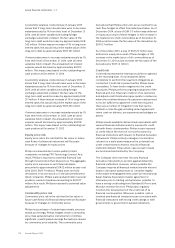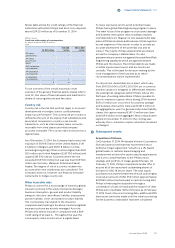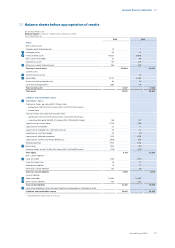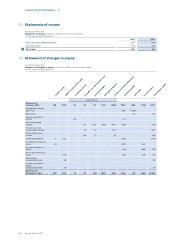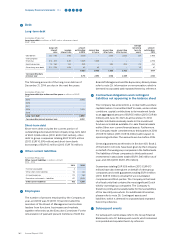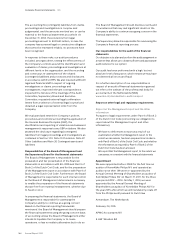Philips 2014 Annual Report Download - page 184
Download and view the complete annual report
Please find page 184 of the 2014 Philips annual report below. You can navigate through the pages in the report by either clicking on the pages listed below, or by using the keyword search tool below to find specific information within the annual report.Company nancial statements 13.5
184 Annual Report 2014
actual coverage varies per account balance and the
depth of our audit procedures per account balance
varies depending on our risk assessment.
Accordingly, our audit coverage per account balance
included in the key audit matters stated below, can be
summarized as follows:
• For goodwill, we have applied a centralized audit
approach with specied audit procedures on 90% of
the goodwill account balance and limited procedures
on the remaining of the goodwill account balance.
•For income taxes, we have identied 10 entities in the
group for which we performed an audit of account
balances and/or specied procedures at the
component level. These 10 entities represent 90% of
the income tax accounts deferred tax assets and
income tax provisions. The remaining population is
covered by limited procedures performed centrally
by the group auditor.
•For revenue recognition, we have identied 31 entities
in the group for which we performed an audit of
account balances and/or specied procedures at the
component level. These 31 entities represent 58% of
sales. This scope is extended by specied procedures
on sales performed centrally, representing an
additional 17% of sales resulting in a coverage of 75%
of sales. The remaining population is covered by
limited procedures performed.
• For contingent liabilities and provisions from legal
proceedings, we have applied a centralized audit
approach with specied audit procedures performed
by the component auditors. Our audit procedures
cover 96% of the recognized legal claim provision
and all signicant legal proceedings without a legal
claim provision recognized.
Audits of account balances or specied procedures
were performed to materiality levels, the majority of
which were based on the relevant local statutory audit
materiality which is considerably lower than Group
materiality. In the other cases, component materiality
was determined by the judgment of the group auditor,
having regard to the materiality for the nancial
statements as a whole and the reporting structure
within the Group. Component materiality did not
exceed EUR 40 million and the majority of our
component auditors applied a component materiality
that is signicantly less than this threshold.
The group auditor sent detailed instructions to all
component auditors, covering the signicant areas that
should be covered (which included the relevant risks of
material misstatement detailed above) and set out the
information required to be reported to the group
auditor. Based on our risk assessment, the group
auditor visited component locations in China, Germany,
Indonesia, the Netherlands, Panama, Singapore and
the USA. Most of our component auditors visited the
Netherlands in 2014 to attend our global audit
conference, which is held every three years, to discuss
the Group audit, risks, audit approach and instructions.
Telephone calls were also held with the auditors of
components that were both physically and not
physically visited. During these visits and meetings, the
audit approach, ndings and observations reported to
the group auditor were discussed in more detail.
We have used other auditors for the audit of
components outside The Netherlands. By performing
the procedures mentioned above at components,
combined with additional procedures at group level,
sector level and at Finance Operations centers, we have
been able to obtain sucient and appropriate audit
evidence regarding the group’s nancial information to
provide an opinion on the nancial statements.
Our key audit matters
Key audit matters are those matters that, in our
professional judgment, were of most signicance in our
audit of the nancial statements. We have
communicated the key audit matters to the Supervisory
Board. The key audit matters are not a comprehensive
reection of all matters discussed.
These matters were addressed in the context of our
audit of the nancial statements as a whole and in
forming our opinion thereon, and we do not provide a
separate opinion on these matters.
Finance Transformation
The Company continued to implement its global
Accelerate! initiative, which includes a Finance
Transformation program. The Finance Transformation
has a signicant impact on the Company’s business
processes, control activities and internal control
responsibilities. We focused on the Finance
Transformation as part of our audit because there is a
signicant risk that a material misstatement could occur
if the program was not implemented with proper
oversight and a focus on maintaining eective internal
controls throughout the process.
Our audit procedures included, amongst others, meetings
with the Board of Management and the Audit Committee
of the Supervisory Board on a regular basis during the
year to understand and monitor the effects of changes to
the Company’s internal control environment, across the
organization. We performed site visits in three major
geographic regions to test the effectiveness of controls
impacted by the Finance Transformation and instructed
our component auditors globally to perform procedures
designed to provide reasonable assurance that a material
misstatement did not exist in the financial statements as
a result of the program. We also tested monitoring
activities executed at different levels of the organization
designed to ensure continued effectiveness of the internal
control framework during the Finance Transformation.
Valuation of goodwill
Under EU-IFRSs, the Company is required to test the
amount of goodwill for impairment, both annually and
if there is a trigger for testing. The impairment tests were
signicant to our audit due to the complexity of the


